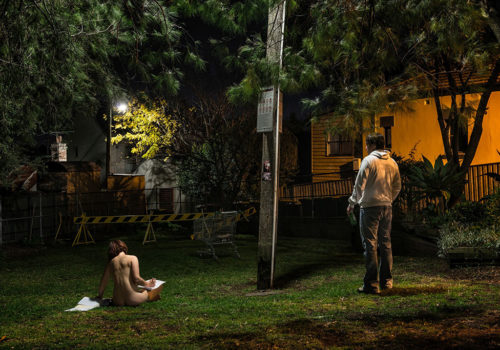Feminine body uncovered; feelings born in the darkness of the night; women presented as nocturnal creatures, honoring their moons. Undulating bodies becoming sinister; the social masquerade dissolved, leaving only skin. This is how Alec Dawson’s Nocturna can be described.
This photo collection consists of images of women involved in situations in which – were they to happen in daylight, the women not naked – the scene would be routine. It is this change in context that illustrates how deep human feelings reach; “the grandiose just as the insignificant, a bottomless pit, impossible to fulfill […] what else could existence be, but desperation.”[1]Naked women show the neglect and loneliness we face every day, even when we’re surrounded by people. We are individual, incomparable beings. Our conscience and thoughts make us unique.
Masks dissolve, nudity speaks without words; expressing through images, only representations of emotions we find in different stages in our lives, those with which we identify, until revived by memories that may have become nostalgic. “The image is capable of communicating and transmitting meaning, without the need of words; including more than can be spoken.”[2]The images of these women show things as intangible as the existence of human desperation in loneliness; the kind that creeps as the night, in silence; a disquieting calm that can only be experienced in those moments when individuality becomes conscious.
The night is also the place where the beings from the lower astral planes, the sinister, the unknown, the terrifying dwell. All the monsters show up at night, although they’re not necessarily something unknown; all to the contrary, they’re our own: our thoughts, our fears, our insecurities, frustrations and traumas. All that forces us to confront the worst of humanity: ourselves. Alec’s pictures show women living with their demons, in the company of night.
The most dangerous demons humans ever face are their own fears and disillusions. That is the moment when we find both the best and the worst about us. At times we become so estranged from our own thoughts, feelings and emotions, that finding ourselves uncovered, naked, means we can no longer hide this alienated nature of ours.
Being human is the only thing we really know first hand; we feel time passing, weather changing. We express our emotions and concerns – we stand before the Universe as ourselves, finite and unstable, and ever changing as it is – as we are. And without it, we literally are nothing.
[1]Kierkegaard, Sören A. Temor y temblor, Fontamara Colección Argumentos: Madrid, 2006, p. 69.
[2]Pallasmaa, Juhani. La imagen corpórea: imaginación e imaginario en la arquitectura, Editorial Gustavo Gili: Barcelona, 2011, p. 28.
Foreword by Daniela Carrillo Romero A.H.
The book is available here: http://www.blurb.com/b/5629062-nocturna
















